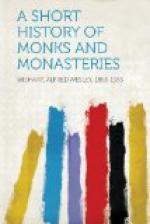India is thought by some to have been the birthplace of the institution. In the sacred writings of the venerable Hindus, portions of which have been dated as far back as 2400 B.C., there are numerous legends about holy monks and many ascetic rules. Although based on opposite philosophical principles, the earlier Brahminism and the later system, Buddhism, each tended toward ascetic practices, and they each boast to-day of long lines of monks and nuns.
The Hindoo (Brahmin) ascetic, or naked philosopher, as the Greeks called him, exhausted his imagination in devising schemes of self-torture. He buried himself with his nose just above the ground, or wore an iron collar, or suspended weights from his body. He clenched his fists until the nails grew into his palms, or kept his head turned in one direction until he was unable to turn it back. He was a miracle-worker, an oracle of wisdom, and an honored saint. He was bold, spiritually proud, capable of almost superhuman endurance. We will meet him again in the person of his Christian descendant on the banks of the Nile.
The Buddhist ascetic was, perhaps, less severe with himself, but the general spirit and form of the institution was and is the same as among the Brahmins. In each religion we observe the same selfish individualism,—a desire to save one’s own soul by slavish obedience to ascetic rules,—the extinction of natural desires by self-punishment. “A Brahmin who wishes to become an ascetic,” says Clarke, “must abandon his home and family and go live in the forest. His food must be roots and fruit, his clothing a bark garment or a skin, he must bathe morning and evening, and suffer his hair to grow.”
The fact to be remembered, however, is that in India, centuries before the Christian Era, there existed both phases of Christian monasticism, the hermit[A] and the crowded convent.
[Footnote A: Appendix, Note A.]
Dhaquit, a Chaldean ascetic, who is said to have lived about 2000 B.C., is reported to have earnestly rebuked those who tried to preserve the body from decay by artificial resources. “Not by natural means,” he said, “can man preserve his body from corruption and dissolution after death, but only through good deeds, religious exercises and offering of sacrifices,—by invoking the gods by their great and beautiful names, by prayers during the night, and fasts during the day.”
When Father Bury, a Portuguese missionary, first saw the Chinese bonzes, tonsured and using their rosaries, he cried out, “There is not a single article of dress, or a sacerdotal function, or a single ceremony of the Romish church, which the Devil has not imitated in this country.” I have not the courage to follow this streamlet back into the devil’s heart. The attempt would be too daring. Who invented shaved heads and monkish gowns and habits, we cannot tell, but this we know: long before Father Bury saw and described those things in China, there existed in India the Grand Lama or head monk, with monasteries under him, filled with monks who kept the three vows of chastity, poverty and obedience. They had their routine of prayers, of fasts and of labors, like the Christian monks of the middle ages.




